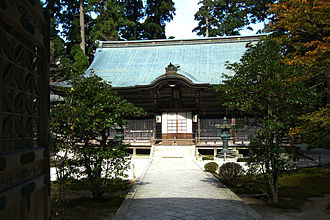Enryaku
Enryaku (延暦) was a Japanese era name (年号,, nengō,, lit. "year name") after Ten'ō and before Daidō. This period started in August 782 and ended in May 806.[1] During this time, the emperor was Kammu-tennō (桓武天皇).[2]
Events of the Enryaku era
- 782 (Enryaku 1, 6th month): Fujiwara no Uona was removed from his office.[3]
- 783 (Enryaku 3, in the 3rd month): Fujiwara no Tamaro died at the age of 62 years.[4]
- 783 (Enryaku 3, in the 7th month): Fujiwara no Korekimi[5] was promoted in the hierarchy of the Imperial court.[4]
- 784 (Enryaku 3): The emperor moves the capital to Nagaoka[6]
- 788 (Enryaku 7): The Buddhist monk Saichō[7] establishes a monastery on Mt Hiei
- 793 (Enryaku 12): Construction began on the Buddhist temple complex at Enryaku-ji.[8]
- 17 December 794 (Enryaku 13, 21st day of the 10th month): The Emperor moved by carriage in a grand parade from Nara to Heian-kyō.[8]
- 796 (Enryaku 15): Copper coins were minted with the legend Ren-hei Ei-hō.[9]
- 797 (Enryaku 16): Shoku Nihongi was written.[10]
- 806 (Enryaku 25): Emperor Kammu died at the age of 70.[11]
Related pages
References
- ↑ Nussbaum, Louis-Frédéric. (2005). "Enryaku" in Japan Encyclopedia, p. 181.
- ↑ Nussbaum, "Kammu Tennō," p. 464; Titsingh, Isaac. (1834). Annales des empereurs du Japon, pp. 86-95; Brown, Delmer et al. (1979). Gukanshō, pp. 277-279; Varley, H. Paul. Jinnō Shōtōki, pp. 148-150.
- ↑ Nussbaum, "Fujiwara no Uona" at p. 211.
- ↑ 4.0 4.1 Titsingh, p.86; Brown, p. 278.
- ↑ Imperial Japanese Commission to the World's Columbian Exposition. (1893). History of the Empire of Japan, p. 106.
- ↑ Nussbaum, "Nagaoka-kyō" at p. 682.
- ↑ Nussbaum, "Saichō" at p. 805.
- ↑ 8.0 8.1 Brown, p. 279.
- ↑ Appert, Georges. (1888). Ancien japon, p. 30.
- ↑ Nussbaum, "Shoku Nihongi" at p. 883.
- ↑ Varley, p. 150; Imperial Household Agency (Kunaichō), 桓武天皇 (50); retrieved 2011-12-27.
Other websites
- National Diet Library, "The Japanese Calendar" -- historical overview plus illustrative images from library's collection
- Imperial Household Agency (Kunaichō), Mausoleum of Emperor Kammu (in Japanese)
| Enryaku | 1st | 2nd | 3rd | 4th | 5th | 6th | 7th | 8th | 9th | 10th | 11th | 12th | 13th | 14th | 15th | 16th | 17th | 18th | 19th | 20th |
|---|---|---|---|---|---|---|---|---|---|---|---|---|---|---|---|---|---|---|---|---|
| 782 | 783 | 784 | 785 | 786 | 787 | 788 | 789 | 790 | 791 | 792 | 793 | 794 | 795 | 796 | 797 | 798 | 799 | 800 | 801 |
| Enryaku | 21st | 22nd | 23rd | 24th | 25th |
|---|---|---|---|---|---|
| 802 | 803 | 804 | 805 | 806 |
| Preceded by: Ten'ō |
Era or nengō: Enryaku |
Succeeded by: Daidō |
